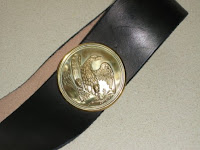
Perhaps the most disappointing thing about Civil War Living History is balancing the hobby with the exigencies of modern life. Work related training kept me from updating this cyber extension of my hobby these past two months even though I managed to attend two events in June—Shenandoah ’62 and a living history at Gaines’ Mill. Ideas for posts came and went. I even started a couple of entries on paper which easily fell pray to the demands of long commutes, exhaustion, and two toddlers. So with all that in mind, I have decided to bear down and reflect upon the anniversary of my first year in the hobby and what it means to me.

This hobby offers a superb escape from the rigmarole of office life in Northern Virginia. At Gaines’ Mill a few weeks ago, Don could not help but exclaim how much he needed to get away from his job. And I do not think there was one of us present that weekend who disagreed with him. In fact, I believe the ability to relax is under assault by the very technology that increases our productivity. We process and transfer data at ever increasing speeds. Our connectivity via the internet increased exponentially just in the past few years. The art of simply sitting around doing nothing has become increasingly difficult in a world that never seems to really sleep anymore. People often ask me what pleasure I derive from dressing up in a wool uniform in the dead of summer and trying to sleep under constant assault by ticks and mosquitoes. Oftentimes, I would trade my cubicle farm, deadlines, and Outlook email for that and the relaxation of just sitting around a campfire shooting the breeze with friends.

Another thing that strikes me about this hobby is the campfire. In Confederates in the Attic by Tony Horwitz, an interviewee laments the lost art of conversation. Long before television introduced us to the passive, non interactive act of watching television, the fire was where man turned for entertainment and commiseration after a long day. I have found a great deal of fireside pleasure since joining this hobby. Our chatter has run the gamut from historical reflection, to idle chatter, to politics, sex, the arts, religion, and reminiscing of times gone by. There is just something about the ambience of chatting by the light of the fire on a dark night with friends. Maybe it is the lighting. Maybe it is the crackle of the fore. Whatever the reason, it is just plain different. Facebook and Twitter do what they do, but they are sure as hell do not do it the way fireside chat does it—personally and intimately.

Finally, this hobby puts me in touch with the primal and masculine pleasures of life and manhood. The media is making millions of dollars off of men seeking to get in touch with their masculine side. Pick up any men’s magazine, browse the bookstore, or turn on the television. In all cases you will be bombarded with interpretations of what it is to be a man, how to do it better, or how to survive like a man. I thought of this at Gaines’ Mill when I was starting the morning fire so we could brew our coffee and make our breakfast. It seems like the Boy Scouts and Cub Scouts are more of an anachronism these days. They still exist, but I am sure their numbers pale in comparison to those who go home to the less rigorous world of video games. Indeed, as I sat there splitting wood with a hatchet, I found myself wondering how many people could even start a fire or chop wood without maiming themselves. I know I am hardly Grizzly Adams when it comes to primitive camping. And I know people of my father and grandfather’s age did things everyday which I would probably call someone to do for me or I would have to learn how to do from a book or the internet. But at a bare minimum, this hobby allows me to reconnect with simple things like building and cooking over a fire, sleeping under the stars, and using a gun. And these are things lots of men are spending millions of dollars to learn to do every year.

My first year in this hobby has been an exciting one. It has taught me quite a few things about the American Civil War which books simply cannot convey no matter how hard they try. It has introduced me to many great people whose love of history and camaraderie is awe inspiring to say the least. I would recommend this hobby to anyone who loves history. And I would advise anyone who wonders why on earth someone would want to put on an itchy wool uniform and sweat their balls off to at least give it a try. It is not as masculine as mountain climbing or as mentally challenging as things other men do to prove themselves. But at a bare minimum it fulfills much of hat we need or are missing from or otherwise humdrum modern lives.



















.jpg)









